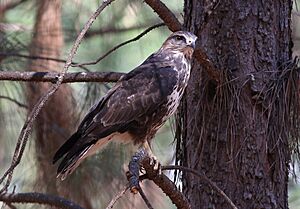Forest buzzard facts for kids
Quick facts for kids Forest buzzard |
|
|---|---|
 |
|
| Conservation status | |
| Scientific classification |
The forest buzzard (Buteo trizonatus) is a cool bird of prey that lives in Africa. Some experts think it might be a type of mountain buzzard, but others say it's its own unique species. This buzzard lives all year round in the woodlands of southern and eastern South Africa.
Contents
What Does It Look Like?
The forest buzzard looks a lot like the steppe buzzard, which visits in the summer. Its head, back, and top of its wings are brown. The edges of its feathers can be reddish-brown, but this changes from bird to bird.
Its chin is white and clear. Its chest and belly are whitish with brown spots. The feathers under its tail are plain white. Some adult buzzards have brown stripes on their chest and belly. Most birds have a special white 'U' shape in the middle of their spotted tummy.
The feathers under its wings are white. They have a reddish-brown tint near the body. There's also a dark, comma-shaped mark at the tip of its main wing feathers. Its upper legs are reddish-brown. The feathers under its wings near its body are white with brown stripes.
Its upper tail is brown with a reddish-brown wash. The tail has thin dark brown bands and a wide dark band near the end. The bands on the underside of the tail can be hard to see.
Forest buzzards are about 41 to 48 centimeters (16 to 19 inches) long. Their wings can spread out to 102 to 117 centimeters (40 to 46 inches) wide.
Where Does It Live and Travel?
The forest buzzard is found only in certain parts of southern Africa. It lives in South Africa, Lesotho, and Eswatini. You can find it from the mountains of eastern Limpopo Province down through the Drakensberg mountains in Kwazulu-Natal to the Western Cape.
These buzzards sometimes move around. They seem to visit the Drakensberg mountains in the Eastern Cape during winter (June to August). There are no records of them breeding there. Two buzzards that were tagged in the east (Kwazulu-Natal and Mpumalanga) were later found in the south of South Africa. They had traveled between 800 and 1300 kilometers (about 500 to 800 miles)!
What Kind of Home Does It Like?
As its name suggests, the forest buzzard loves to live in evergreen forests. This includes forests with trees like eucalyptus and pines that were planted by people. The steppe buzzard, on the other hand, prefers open areas. So, if you see a buzzard, just knowing its habitat might not be enough to tell the two species apart.
How Does It Live?
The forest buzzard hunts along the edge of the forest or inside it. It's a "sit and wait" hunter. This means it sits quietly on a branch and waits for prey to come by. Then, it pounces!
It eats small animals like tiny mammals. It also preys on birds, even ones as big as a turaco or a francolin. Snakes, lizards, and frogs are also on its menu. For insects, it eats grasshoppers, wasps, beetles, and even scorpions.
We don't know a lot about how they raise their young. But we think they stay in their own territory and mate with only one partner. Their nest is big and made of sticks. Inside, it's lined with soft green leaves and sometimes a fuzzy plant called beard lichen. They usually build their nests in a tree fork or on a lower branch deep inside the forest. They like pine or eucalyptus trees, but also native trees like the small-leaved yellowwood.
Female buzzards lay two eggs between August and November. Most eggs are laid in September or October. The eggs hatch at different times. The first chick to hatch is often mean to its younger sibling. It might stop the younger one from getting food. If there isn't enough food, the younger chick might not survive. The young buzzards fly out of the nest when they are about 47 days old. They become fully independent when they are about four months old.
How Are They Related to Other Birds?
The forest buzzard is part of a larger group of birds that includes the common buzzard and the Madagascar buzzard. It's also related to the mountain buzzard. Experts decided to call the forest buzzard and mountain buzzard different species. This is because they live in different places, look a bit different, and their family trees don't quite match up.
It's possible that the forest buzzard came from the steppe buzzard. Steppe buzzards are common visitors in southern Africa during winter. They can live in many different places and breed over a huge area.
Is It Endangered?
The forest buzzard used to be considered a threatened bird in South Africa. But now, there are more planted forests, and the buzzards have learned to breed in these new areas. This has helped their population grow! Because of this, the IUCN now lists it as "Near Threatened." This means it's not in immediate danger, but we still need to keep an eye on it.


